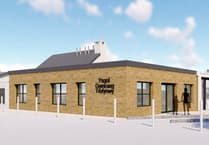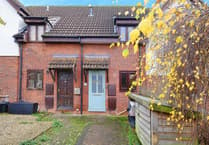IN the second of a series looking at the streets of Abergavenny we reveal the fascinating history of Nevill Street.
UNLIKE its worn, town, and broken neighbour, Tudor Street, Nevill Street has fortunately managed to escape the unrestrained ravage and gleeful maul of modernization. The towering symmetry and impressive facade of its regal collection of Elizabethan and Georgian buildings suggest a proud and intriguing history. The suggestion is not wrong.
Cows and Roses
Named after the old lords of Abergavenny, this popular thoroughfare and architectural delight was once named Cow Street because you guessed it, livestock used to be sold in this neck of the woods.
When farmers used to bring their cows here, they would tie them up in Castle Meadows for a few days beforehand and let them get plump off the fat of the land before herding them up Byfield Lane on their way to market.
It is often suggested that a faint odor of bull dung can still be detected in and around the area of 13 Nevill Street. How much truth there is in this old wive’s tale we’ll perhaps never know.
Anyhow, onward and upwards.
Living and working in a place called Cow Street didn’t sit well with the fine folk who ended up living here and so it was renamed Rother Street, which sounds slightly more respectable. And because Rother in the Anglo-Saxon tongue refers to a breed of horned cattle the old street got to maintain its bovine links.
There still exists a subtle nod to Nevill Street’s past on the old Cow Inn building which until recently was occupied by The Trading Post. If you look up you’ll see there are a sturdy selection of bullheads just below the roof keeping a watchful eye on proceedings to this day.
The building was originally built in 1600 and the Vaughan family of Tretower Court used it as a townhouse. Look closely beneath the windowsills and you’ll see a curious design of the heads of three children entwined with serpents. It’s actually the Vaughans family arms. Local legend has it that it symbolises how triplets of this family once entered the world with their mother’s umbilical cord wrapped around their necks. You’ll also notice the red rose of Lancaster and the white rose of York. This is a little reminder that members of the Vaughan family fought on both sides during the Wars of the Roses.
While we’re here it’s worthwhile to note for all you pub quizzers out there that Sir Roger Vaughan was mortally wounded at Agincourt whilst fighting for Henry V.
As mentioned, the Vaughan’s townhouse would later become a public house called the Cow Inn where cattle drovers would take their fill of ale and strike a hard bargain. It also doubled up as a post office in the eighteenth century. And as a sign of the times, in 1873, it changed its name to the Cow Temperance Hotel.
By the turn of the 20th century, it was being used as dining rooms and boarding rooms for a few of the pupils at Castle Street school.
The Gentleman’s Club
In 1912 The Cow Inn was renamed the Nevill Temperance Hotel and was at some point the headquarters of an organization calling itself The Gentleman’s Club.
A poem from an old copy of the Chronicle describes this strange society thus - “The Gentleman’s Club ’tis called - that we’ll allow, for they say so themselves, and ’tis kept at the Cow. And if ever sign meant a true emblem n life, ’tis exemplified here, in our landlord’s good wife. The man’s too as supple, as kind as a glove. They’re abundant in children, abundant in love.”
From 1937 the old Cow became known as Unity House and was the local labor party’s headquarters.
This lovely old building currently stands empty but let’s hope it opens its doors again soon and begins a new chapter in the history of Nevill Street.
Nevill Street was also home to Abergavenny’s first bank. This great financial institution was set up in the distant days of 1810. It was established by Blaenavon iron masters Thomas Hill and Samuel Hopkins with a little help from their partner Lewis Osborne. Money men don’t tend to be an imaginative lot and so it was simply named the Abergavenny Bank.
A Street Full Of Boozers
Besides the Cow Inn, there were a number of other notable watering holes in Nevill Street back in the day. You had the Bull, the Black-A-Moor’s Head, the Dragon’s Head Inn, the Raven Hotel, and of course the King’s Arms, which sadly is the last man standing.
The Dragon Head’s Inn later became that great little dark and dingy boozer locals knew as the British Legion club.
During its renovation in 1961, a rather crude painting of a heraldic lion rampant was discovered on an interior wall. Why? No-one knows but it was quickly covered up again in case it upset any of the Legion’s beer lovers.
Nowadays the former Legion has become the world-famous coffee pot, which has a handy habit of creating the sort of unusual drinks that go viral on Facebook.
The brilliantly named Raven Hotel (No 1-3 Nevill Street) would naturally have been the drinking den of choice for Edgar Allan Poe if the Boston bard had ever ventured to these shores.
However, the peculiar choice of pub name was thought to be a direct result of Abergavenny’s stubborn nature.
The story goes that in 1689 the Town Mayor flat out refused to swear his allegiance to William of Orange because he and most of the town’s folk remained loyal to the recently replaced Stuart King James II.
As a result, the town’s borough charter was removed, but in a show of defiance, the Raven Hotel continued to fly the flag of the Raven which was then the Jacobite symbol of loyalty to the Stuart. No doubt many a toast to king and country was held in this illustrious Nevill Street pub.
The Raven later became known a Waterloo House and by 1845 it was a surgery for famous local physician Samuel Steele. From 1884 until 1947 the building was the headquarters of Cadle’s Grocery.
Back in the day and we’re talking 1712 here folks, there also used to be a King’s Head operating out of number seven Nevill Street and a past landlord who had the splendid name of Jehosophat Jones.
The King’s Arms is still perched on the corner of Nevill Street and continues to bear the royal arms of Charles II on the frontage on its bright yellow exterior.
In 1817, two years after the Battle of Waterloo, a troop of the King’s and 15th Hussars stayed there. They were in town to basically beat up unemployed people in Tredegar and Natnyglo who had the brass neck to rebel against the status quo.
Over the fireplace in the lounge of the King’s Arms you can see still see where the soldiers inscribed, “Good Quartering Forever 1817 King & 15 Huzzars Hall Troop 24.”
The King’s Arms is also said to have a ghost in the form of the White Lady. This unhappy soul was apparently raped by a perverted monk who was once offered sanctuary at the inn.
The White Lady died in childbirth, and to this day is thought to still roam the upstairs rooms, lost and alone, eternally searching for the child she never got to hold in her arms.
As for the vile monk, justice caught up with him in a big way and he was hung drawn and quartered at Monmouth.
Chariot Races and Angry Miners
An interesting little tale regarding Nevill Street’s Bull Inn concerns the one-time licensee Mr. Edwards. The story goes that one Bank Holiday weekend with Aber teeming with miners and steel men, Mr. Edwards kicked out one of the colliers and gave him a serious eye injury in the process.
The other miners weren’t too happy about this and hundreds of them flocked from all of the other pubs in town to gather outside the Bull demanding revenge. Reports from the scene indicate that he night was alive with enough voices to fill ten male voice choirs. All of them, to a man, calling for Mr. Edward’s blood and fiercely chanting, “Crucify him crucify him!”
Fortunately, Mr. Edwards had taken the precaution of barricading his doors and windows and the drunken commotion soon died a death.
One of the most familiar faces on Nevill Street was the notorious Denny Taylor. Denny lived with his mother in a small cottage on St John’s Square but he could be often found well oiled and standing upright in his cart as he lashed the terrified pony into a wild gallop along the Nevill Street cobbles. Locals described watching Denny in full-flight as like watching the Roman chariot race scene from Ben Hur.
A Cut Above
At number two Nevill Street there was once a tailor. Mr. Price the proprietor was said to be a very portly gentleman with a shock of white hair. Sartorial standards were a lot higher in those distant days. There was no such thing as a tracksuit or leisure wear for people to shuffle around aimlessly in. What there was, was the full monty! Which in plain speak translates to a well-cut suit courtesy of everybody’s favourite high street tailor of taste - Montague Burton. Burton’s, of course, was the tailor of choice for a long time in Nevill Street.
When old Montague died in 1952 there were a staggering 615 Burton stores in the UK. Not a bad job for a Lithuanian Jew who came to the country in 1900 and borrowed £100 quid to set up that most ‘British’ of menswear businesses. But now like all empires, Montague’s seems to have gone for a Burton. Prior to 1915, Burton’s premises was the Westwood Garage. The old building currently stands as vacant as a rudderless ship at midnight, but Mountain Warehouse is due to move in sometime soon and give it a new lease of life.
An Educated Lot
According to the 1952 census, there were once three private schools in Nevill Street, at number 19, 23, and 13. Now know as Tindle House, number 13 used to be called Nidra House and was once occupied by a French lady called Madam Ardin, who also opened a draper shop.
Number 19 Nevill Street used to be the abode of John Owen and his brother Edwin. The two originally hailed from Dolgellau and set-up a printing press together known as the Minerva Press.
John Owen was a well-known figure throughout Wales for his conducting work with the National Eisteddfod. Until his death in August 1959 at the grand old age of 93, Mr. Owen’s musical and religious activities and his lively personality were admired not only in Monmouthshire but throughout Wales. He was a brilliant eisteddfodwr, but his enthusiasm took many other forms, including elocution, painting, preaching, drama and sky watching. Until he reached his 80s, motoring and cycling could be added to the list.
His office in Nevill Street became the meeting place for members of the local Welsh speaking community. In 1949 he was given the freedom of Abergavenny and a year later awarded the OBE. When he died on December 30, 1960, he was said to have been the ‘patron saint of Gwent’.
Powdered Wigs And Old Hacks
In the 18th Century, Abergavenny was renowned for the quality of its white periwigs, and hair bleacher extraordinaire, Jimmy Jones, used to live in Nevill Street circa 1741.
And last but by no means the least, what history of Nevill Street would be complete without mentioning that before he founded the Abergavenny Chronicle in 1871, local businessman Edwin Morgan originally attempted to launch a newspaper in 1864 called the Abergavenny Gazette. It was an ill-fated affair and but a blueprint for the Chronicle, but guess where the unpopular rag was printed before it folded? Here’s a hint it begins with ’N’ and rhymes with the devil.
You got it! And after being bandied from pillar to post during the last 148 years in an attempt to find a permanent base, the Chronicle finally returned to Nevill Street in the mid-nineties and it felt like coming home to a little area of Abergavenny that has a unique and captivating charm all of its own.
If you’ve got any old pictures or stories about the Streets of Abergavenny, then get in touch and contact Tim Butters on 01873 852187 (30), or email him on [email protected].




